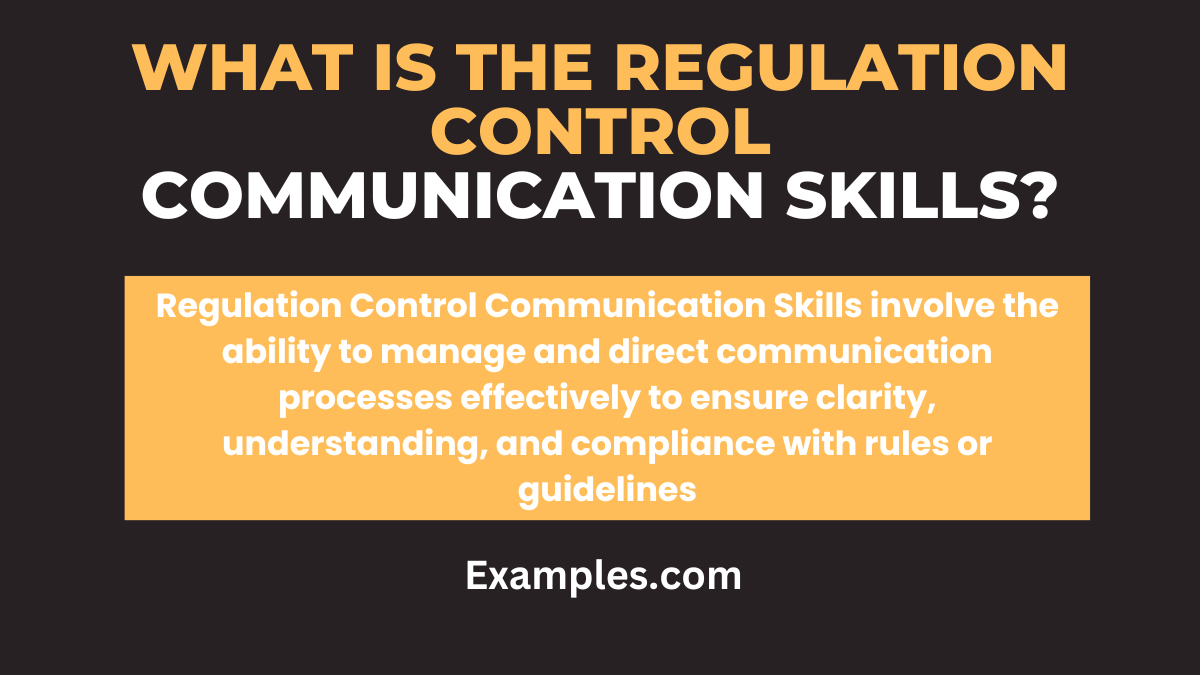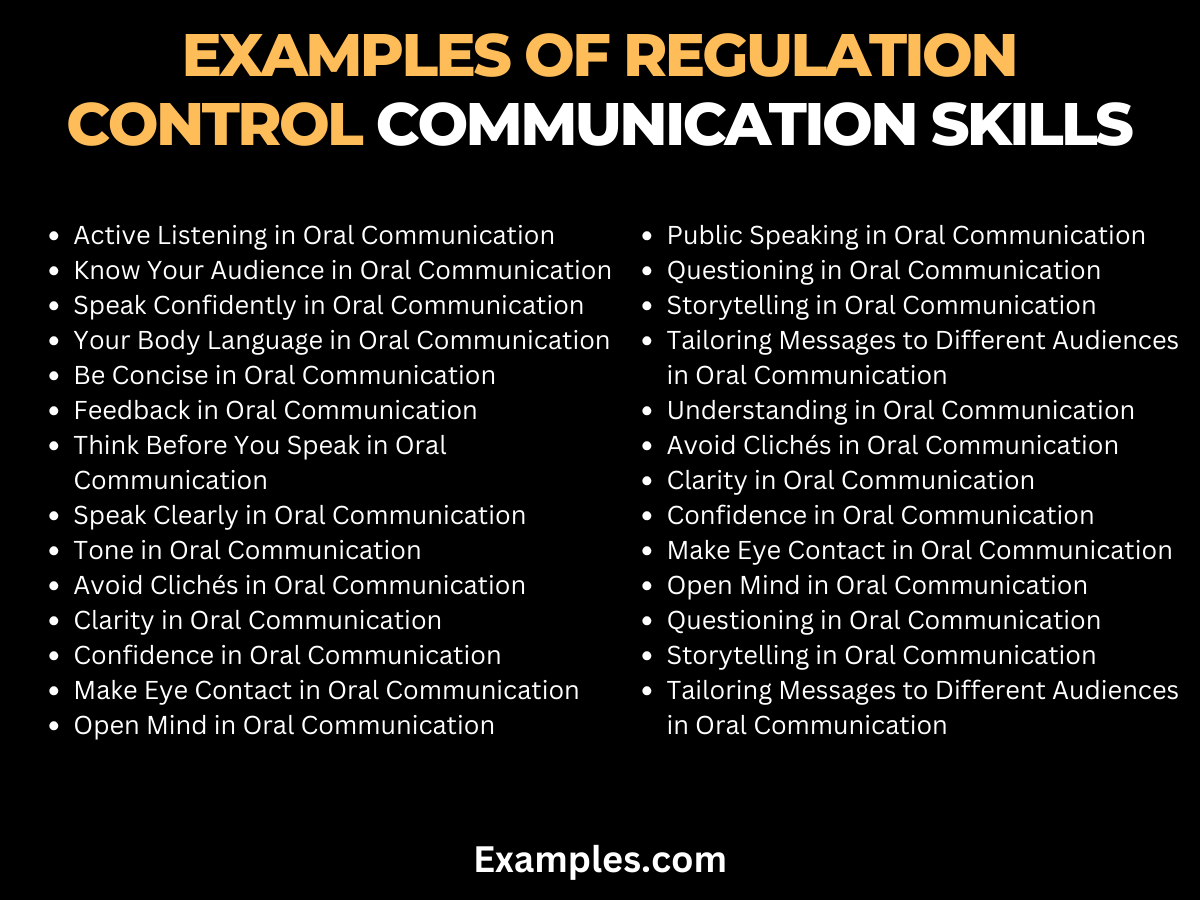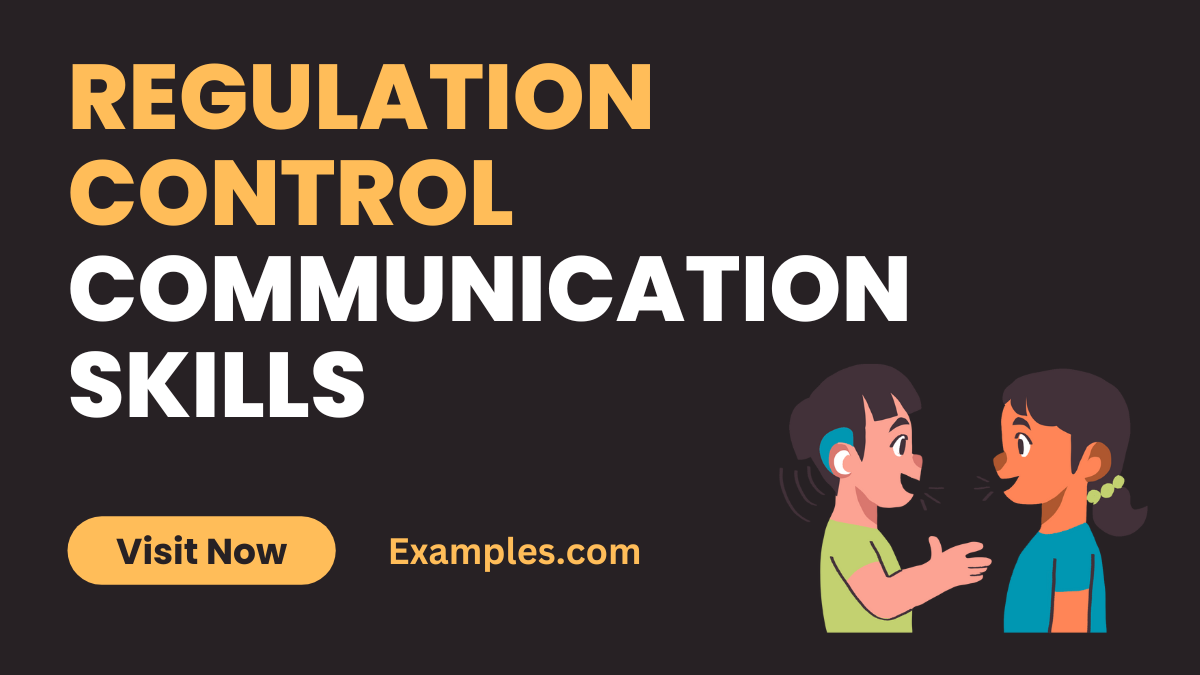29+ Regulation Control Communication Skills Examples
Regulation Control Communication Skills are more vital than ever. This guide delves into the art of managing and expressing thoughts and emotions in communication effectively. Whether you’re a professional, student, or just keen on enhancing your interpersonal skills, understanding and applying these techniques can significantly impact your interactions and relationships. Here, you’ll find insights into mastering these skills, from active listening to effectively conveying your message in various contexts
What is the Regulation Control Communication Skills?

Regulation Control Communication Skills involve the ability to manage and express one’s own emotions and understand others’ emotions during communication. These skills are crucial for creating clear, respectful, and empathetic interactions.
30 Examples of Regulation Control Communication Skills

Regulation control communication skills are essential for managing conversations and guiding them towards productive outcomes. These skills involve the ability to moderate, direct, and adjust the flow of communication to ensure clarity, understanding, and efficiency. Effective regulation control enhances interpersonal interactions, decision-making processes, and problem-solving in various settings. Mastering these skills is crucial for maintaining balance and focus during discussions, making them indispensable in personal and professional environments.
1. Active Listening in Oral Communication
Active listening in oral communication is a critical skill that involves fully concentrating, understanding, responding, and then remembering what is being said. It’s more than just hearing; active listeners engage with the speaker both verbally and nonverbally to show understanding and interest. This skill is vital in fostering effective communication, building rapport, and ensuring clarity.
Example: In a team meeting, when a colleague presents an idea, an active listener might nod, maintain eye contact, and respond with, “I understand you’re suggesting we prioritize project X due to its immediate impact. That’s a thoughtful approach.”
2. Know Your Audience in Oral Communication
Understanding your audience in oral communication is crucial for effective message delivery. It involves tailoring your language, tone, and content according to the listeners’ needs, expectations, interests, and level of understanding. Knowing your audience ensures that the communication is relevant, engaging, and easily comprehensible.
Example: When presenting a technical topic to non-experts, you might say, “Let’s break down these complex terms into simpler concepts to ensure everyone grasps the fundamentals of our project.”
3. Speak Confidently in Oral Communication
Speaking confidently in oral communication involves projecting assurance and certainty in your voice and body language. Confidence in speaking can persuade and influence listeners, create a positive impression, and facilitate clearer understanding.
Example: During a presentation, confidently stating, “Our strategy is innovative and has proven successful in initial tests,” can inspire trust and interest in your audience.
4. Your Body Language in Oral Communication
Body language in oral communication is the non-verbal signals that accompany your words, including facial expressions, gestures, posture, and eye contact. Effective use of body language can reinforce your message, demonstrate confidence, and engage listeners.
Example: In a negotiation, leaning forward slightly and maintaining eye contact can convey your interest and commitment to the discussion.
5. Be Concise in Oral Communication
Being concise in oral communication means expressing your thoughts clearly and briefly without unnecessary details. Conciseness helps in maintaining the attention of your audience and ensuring your message is understood without confusion.
Example: Instead of elaborating extensively, you might say, “Our main goal is to increase efficiency by 30% within the next quarter, using streamlined processes.”
6. Feedback in Oral Communication
Feedback in oral communication is the process of providing constructive responses to a speaker. Effective feedback can guide improvements, affirm strengths, and foster better understanding and learning.
Example: After a colleague’s presentation, you might offer, “Your detailed analysis was excellent. Perhaps next time, a summary of key points at the start could help in grasping the overall concept quicker.”
7. Think Before You Speak in Oral Communication
Thinking before speaking in oral communication involves pausing to organize your thoughts and considering the impact of your words. This practice helps in avoiding misunderstandings, conveying clear messages, and maintaining positive relationships.
Example: In a heated discussion, instead of responding impulsively, take a moment and then say, “I understand your concerns; let’s explore how we can address them effectively.”
8. Speak Clearly in Oral Communication
Speaking clearly in oral communication means articulating words distinctly and using appropriate pace and volume. Clear speech helps in ensuring your message is understood correctly and reduces the chances of miscommunication.
Example: When instructing a team, speak at a measured pace: “First, complete the client analysis, then, by Wednesday, start drafting the report.”
9. Tone in Oral Communication
The tone in oral communication refers to the quality, pitch, and strength of your voice, conveying attitudes and emotions. The appropriate tone can make your communication more effective and empathetic.
Example: When giving constructive feedback, use a supportive tone: “I believe with a bit more focus on details, your work will be outstanding.”
10. Avoid Clichés in Oral Communication
Avoiding clichés in oral communication means steering clear of overused expressions and phrases. Original and specific language keeps your communication fresh and engaging.
Example: Instead of saying, “Think outside the box,” you might say, “Let’s approach this problem from a new, creative angle.”
11. Clarity in Oral Communication

Clarity in oral communication is about expressing ideas in a straightforward and understandable manner. It involves using precise language and avoiding ambiguity to ensure the message is comprehensible to the audience. Clarity enhances effective exchange of ideas and reduces misunderstandings.
Example: In a project briefing, instead of using jargon, say, “We’ll first gather consumer insights, then develop targeted marketing strategies based on these insights.”
12. Confidence in Oral Communication
Confidence in oral communication reflects in the assertiveness and self-assurance with which one speaks. It’s about expressing thoughts without hesitation or ambiguity, which helps in persuading and motivating others. Confident communication can significantly impact the effectiveness of the message conveyed.
Example: When proposing a new idea, assertively state, “Based on our research, this strategy will yield the best results in the current market scenario.”
13. Get Rid of Conversation Fillers in Oral Communication
Eliminating conversation fillers, like ‘um,’ ‘uh,’ or ‘like,’ in oral communication makes your speech more professional and fluent. These fillers can detract from the impact of your message and make you seem less confident.
Example: Practice speaking without fillers: Instead of saying, “Um, our goal is, uh, to increase sales,” say, “Our goal is to increase sales.”
14. Make Eye Contact in Oral Communication
Making eye contact in oral communication is a powerful way to connect with your audience, showing you are engaged and sincere. It helps in building trust and making your interactions more personal and effective.
Example: During a presentation, periodically make eye contact with different audience members to engage them directly.
15. Open Mind in Oral Communication
Having an open mind in oral communication involves being receptive to new ideas and perspectives. It encourages healthy discussions and creative problem-solving, fostering a collaborative environment.
Example: In a brainstorming session, encourage diverse opinions: “I’m interested in hearing different perspectives on this issue.”
16. Public Speaking in Oral Communication
Public speaking in oral communication is the ability to effectively communicate a message to a group. It involves clear articulation, engaging storytelling, and audience interaction to convey your message convincingly and memorably.
Example: In a public speech, use a story to illustrate your point: “Let me share a story that perfectly encapsulates our mission.”
17. Questioning in Oral Communication
Effective questioning in oral communication is about asking clear, purposeful questions that elicit useful information or encourage deeper thinking. It’s a crucial tool for engaging others and gaining insights.
Example: In a team meeting, ask open-ended questions: “What are your thoughts on the potential impact of this decision?”
18. Storytelling in Oral Communication

Storytelling in oral communication is a powerful technique to make your message more engaging and memorable. It involves weaving facts and information into a narrative that resonates with your audience.
Example: When explaining a concept, use a relevant anecdote: “This reminds me of a situation where a simple change resulted in a huge improvement.”
19. Tailoring Messages to Different Audiences
Tailoring messages to different audiences in oral communication involves adapting your language, tone, and content based on who you’re speaking to. This customization ensures that your message is relevant and relatable to each specific audience.
Example: When talking to technical experts, use industry-specific terminology, but simplify your language for a general audience.
20. Understanding in Oral Communication
Understanding in oral communication refers to the ability to accurately interpret and respond to the messages of others. It’s about empathetically listening and comprehending the underlying meanings and emotions in a conversation.
Example: In a sensitive discussion, reflect understanding: “I see this is important to you. Let’s explore how we can address it together
21. Adapting Communication Styles
Adapting communication styles in oral communication is about altering your approach to suit different situations and audiences. This flexibility ensures effective interaction, whether in formal settings or casual conversations.
Example: In a formal meeting, use a professional tone and language, while in a casual team gathering, a more relaxed and informal style would be appropriate.
22. Nonverbal Communication Cues
Nonverbal communication cues in oral communication include gestures, facial expressions, and body posture, which complement and reinforce spoken words. These cues are crucial in conveying emotions and attitudes.
Example: During a persuasive speech, using hand gestures can emphasize key points and convey enthusiasm.
23. Empathy in Oral Communication
Empathy in oral communication involves understanding and sharing the feelings of others. It’s key in building rapport, resolving conflicts, and enhancing relationships.
Example: When a colleague is upset, saying, “I understand why this is frustrating; let’s work on it together,” shows empathy.
24. Cultural Sensitivity in Oral Communication
Cultural sensitivity in oral communication refers to acknowledging and respecting diverse cultural backgrounds and perspectives. This sensitivity promotes inclusivity and effective cross-cultural communication.
Example: In a multicultural team, avoid idioms or references specific to one culture, and instead use universally understood language.
25. Listening for Feedback in Oral Communication
Listening for feedback in oral communication means paying attention to the responses of your audience to adjust your message accordingly. It’s about being receptive to both verbal and nonverbal feedback.
Example: If the audience seems confused, clarify: “Let me explain this point further for clarity.”
26. Articulating Complex Ideas Simply
Articulating complex ideas simply in oral communication is the skill of breaking down complicated concepts into easy-to-understand language. This clarity is essential for effective knowledge transfer.
Example: To explain a technical process, use simple analogies: “Imagine this system as a network of roads directing traffic to its destination.”
27. Maintaining Professionalism in Speech
Maintaining professionalism in speech involves using respectful, clear, and appropriate language. It’s vital for creating a positive impression and maintaining workplace decorum.
Example: Addressing colleagues or clients, use formal greetings and a respectful tone: “Good morning, Mr. Smith. I’m looking forward to our discussion today.”
28. Using Humor Effectively
Using humor effectively in oral communication can engage and relax your audience, making your message more memorable. It should be used appropriately and sensitively.
Example: In a light-hearted presentation, a relevant joke or amusing anecdote can break the ice and engage listeners.
29. Negotiation Skills in Oral Communication

Negotiation skills in oral communication involve discussing and reaching mutually beneficial agreements. It requires clear articulation, active listening, and compromise.
Example: During a negotiation, say, “I understand your concerns. Let’s find a solution that works for both of us.”
30. Effective Use of Voice Modulation
Effective use of voice modulation in oral communication means altering pitch, volume, and pace to enhance the delivery of your message. It helps in maintaining audience interest and emphasizing key points.
Example: When highlighting an important point, slightly raise your volume and slow your pace for emphasis
Importance of Regulation Control Communication Skills
Regulation control communication skills are essential for effectively managing interactions in various contexts. These skills encompass the ability to regulate and control one’s own emotions, thoughts, and behaviors during communication, ensuring that the message is conveyed clearly and appropriately. Here’s why they are vital:
- Enhances Effective Communication: Mastery of regulation control aids in expressing thoughts and emotions effectively, preventing misunderstandings.
- Promotes Emotional Intelligence: It involves understanding and managing one’s emotions, leading to better interpersonal relationships.
- Conflict Resolution: Effective regulation control helps in managing conflicts by keeping conversations constructive.
- Improves Decision Making: Clear and controlled communication aids in making informed decisions, as it allows for the precise expression of ideas and concerns.
- Builds Trust and Rapport: Consistent and controlled communication fosters trust, essential in both personal and professional relationships.
Regulation Control Communication Skills at Workplace
In the workplace, regulation control communication skills play a crucial role in maintaining a productive and harmonious environment. Here are key aspects:
- Conflict Management: Managing conflicts with a calm demeanor prevents escalation and maintains a positive work environment.
- Team Collaboration: Effective regulation control fosters teamwork by facilitating open and respectful dialogue.
- Leadership: Leaders with strong regulation control inspire confidence and respect, leading to more effective team management.
- Feedback in Oral Communication: Giving and receiving feedback constructively is vital for personal and team growth.
- Think before you speak in Oral Communication: This ensures that communication is purposeful and relevant, enhancing clarity and understanding.
Regulation Control Communication Skills in Nursing
In the field of nursing, regulation control communication skills are critical for providing quality patient care. They include:
- Patient Interaction: Effective regulation control ensures empathetic and clear communication with patients, enhancing their comfort and understanding.
- Team Coordination: Nurses must communicate effectively with other healthcare professionals, ensuring accurate and efficient patient care.
- Handling Stressful Situations: Nurses often encounter high-stress situations where controlled communication is crucial for quick and effective decision-making.
- Active listening in Oral Communication: This ensures understanding of patients’ needs and concerns, leading to better care.
- Clarity in Oral Communication: Clear communication in nursing avoids misunderstandings and errors, which are critical in healthcare settings.
In conclusion, mastering regulation control communication skills is a vital aspect of effective oral communication. These skills not only facilitate smoother interactions but also ensure that conversations are productive and goal-oriented. By effectively regulating the flow of dialogue, maintaining focus on the subject at hand, and ensuring that all participants are actively engaged, individuals can significantly enhance their communication efficacy in both personal and professional spheres. Additionally, integrating these skills into everyday communication practices contributes to the development of strong leadership qualities and fosters a collaborative environment.
To further explore the intricacies of communication skills and their impact, resources such as Harvard University’s Program on Negotiation offer valuable insights. This platform provides a wealth of information on negotiation strategies and communication techniques that can be applied in various scenarios. Additionally, for those interested in delving deeper into the psychological aspects of communication, the American Psychological Association offers a range of articles and research papers that explore the dynamics of interpersonal communication and its effects on relationships and teamwork.



